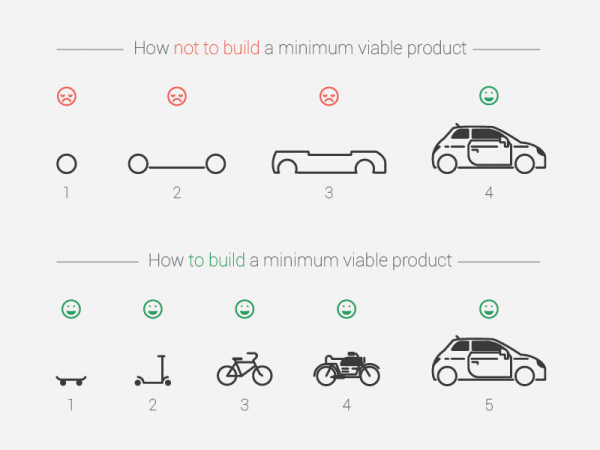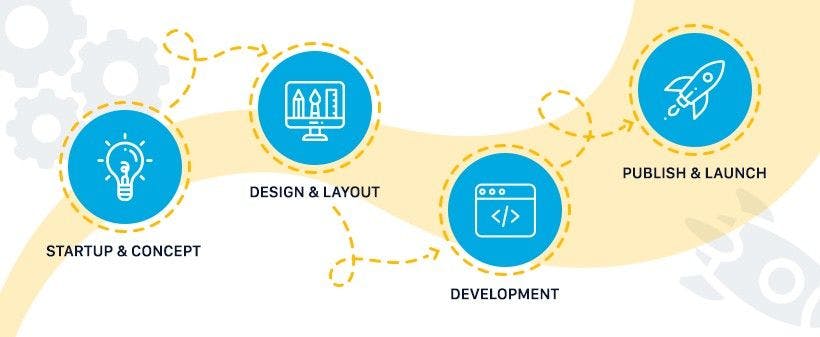
Why is a Minimum Viable Product (MVP) Important for Software Development?
Building a startup is a risky endeavor since it often has to do with implementing technologies that are new to the industry, creating a never-thought-of-before service or product. While it is tempting for business managers to build something innovative and groundbreaking, there’s always a risk that a project will be irrelevant to the end-user.
In order to be confident that your future project will appeal to a prospective audience, you need to validate the idea before spending time, money, and effort into designing the tool. Creating a minimal viable product, also known as MVP, is an efficient way to do it. In this post, you will find out what is mvp in software development and why there’s no way for your business to miss out on it.
What Is an MVP in Software Development?
An MVP in software development projects is a prototype of the product that, despite having the essential features of the end software, is cheaper and quicker to develop. Its main purpose is to see if there’s enough demand to justify the development costs and time needed to create the software.
Usually, an MVP has a basic interface and feature set. As soon as it’s released, the minimal viable product is distributed to beta testers or focus groups — these early adopters complete the testing of the prototype and offer constructive criticism.
If you’re wondering why mvp is important for software development, it’s because this is a powerful source of insights. After presenting it to the public, a business owner will have an understanding of what customers’ expectations are and whether or not the final result will be able to meet them.

There are four major MVP types:
- Concierge MVP — handling all the processes that will be automated manually. This is one of the cheaper minimal viable product types since it allows you to test the idea of your product without developing the actual software. As a long-term solution, a concierge MVP is an inefficient way to attract and retain customers — that’s why most companies only use it in the founding stages, eventually replacing manual work with automated.
- Email MVP. Since describing an idea in an email is much cheaper than developing a product, it’s common for companies to create email MVPs. If you get favorable feedback from prospective audiences — that’s how you know that the idea is worth pushing further. The practice of sending out email MVPs was used among some of the major companies — think ProductHunt as an example.
- Landing page MVP is another concise way to validate the concept by creating a dedicated landing page about the product even if the software is not developed yet. Such prototypes typically include an idea description, the advantages it offers to the audience, and a form that lets users leave their email and join the team of early product adopters. If a landing page MVP for a software development project is successful, it makes sense to invest in designing a product that fits the concept.
- Wizard of Oz MVP is a visual illusion of the functional product that gives prospective users a look and feel of the solution without carrying out any activities. The practice involves designing the interface of the app and carrying every action that’s supposed to be automated in the final build manually. This type of MVP is an extension of the Concierge MVP practice.
Why Build an MVP For a Software Development Project?
An MVP helps get as much uncertainty as possible out of the team’s way. By developing a product that loosely resembles the ready software and sharing it with users, project teams can forecast the demand for a future solution, plan the development process with skyrocketing precision, and find out what improvements would make the product more efficient and easier to use.
Why is MVP important for software development? Here are a couple of reasons:
- Defines the direction for the design. Other than validating the concept, creating an MVP helps bring in a fresh perspective and give the development team a better idea of what features and interface elements users would expect from a similar product. All collected data will come in handy when developing and designing the software and help meet the audience’s expectations.
- Validates the functionality of features. The role of MVP in your software development is that it ensures that the system works in the same way that a business owner envisioned it. If a product involves creating custom features, it’s crucial to ensure that the team is skilled and resourceful enough to bring them to life and have them function properly. In case there are bugs or defects that compromise the functionality of the product, it’s better to pinpoint them during the development stage, not after the final release.
- Tests the demand for a unique set of features. When an innovative product is in development, a company manager might wonder if it helps the audience solve daily problems, the app’s working principles are understandable, and the final product is easy to use. Unfortunately, more often than not, it turns out that a prospective app user has a faster and more efficient way to solve the problem. Teams develop a minimum viable product to see if a solution is truly the best way to get the desired outcome.
- Improves the precision of project planning. When working on a minimum viable project, the team has to fully conceptualize the software, decide which features are included, which technology stack will be used, etc. When it’s time to work on a product, the MVP is often used as a reference point, improving the planning precision, the quality of communication within the team, and the efficiency of development.
The Benefits of a Minimum Viable Product in Software Development
Developing an MVP falls in line with the build-measure-learn paradigm that allows companies to get insights and continuously improve the product based on the data that was captured during the release of the prototype.
Sometimes, an MVP helps identify a new pain point or a new audience to target. Also, it helps package and present the features the right way. Although designing an MVP feels like a considerable investment to make, the advantages of using MVP provide a solid return on investment.
- Convincing stakeholders and attracting investors
It’s common for startups to include minimum viable products in a pitch deck. A usable prototype stands as proof of the team’s commitment to the project. A minimum viable product makes the decision-making process for stakeholders and investors considerably more risk-free.
Having an MVP helps increase brand awareness within the startup community. If you’re hiring, attracting skilled talent will be easy if you have a functional product that speaks a thousand words about your vision and idea. - Increasing the cost-efficiency of the project
Developing a minimum viable product help understand which features are the most necessary ones for the success of the product and which ones are not as popular among beta-testers.
Thanks to MVPs, teams can avoid building overly complex solutions — that will reduce development and maintenance costs exponentially. Before hiring extensive departments, business owners can have a better understanding of what kind of talent they need.
You can read more about MVP prices in our other article. - Speeding up the development process
MVP helps keep the team focused on the end goal — a fully functioning product. Using the minimum viable product as a point of reference helps reduce uncertainty and prevent procrastination within the team, shortens the feedback loop, and increases the overall development speed. - Reducing room for error
As the project gets more complex, there are more people and system components involved in the process. Eventually, it’s getting harder to control the development process.
A minimum viable product in software development helps newcomer developers familiarize themselves with the system. Also, referencing an MVP encourages developers to not overcomplicate and reduce the amount of coding and potential errors, reducing the number of system shutdowns and facilitating maintenance management. - Fostering relationships with prospective customers
An MVP lays a solid groundwork for a future product. While the development team can work on creating a solution that fully satisfies the audience, the marketing team can build connections with potential customers early on and spread the word about the product around the web, thus luring in future committed daily active users.

Our Experience
At Gearheart, we understand that every product is different — that’s why we don’t use a one-size-fits-all MVP development strategies. However, our software experts have developed a working development framework that helped us validate the concepts behind multiple small-, medium-, and large-scale businesses.
- Creating a prototype. We work on high-fidelity prototypes that are good-looking, interactive, and functional.
- Launching the MVP and collecting the feedback. By setting up pictures and integrations with analytics platforms, we help business owners capture relevant data and use it during the decision-making process.
- Providing continuous assistance during the development process. If you want to build an app in-house, Gearheart specialists are happy to help with tips and insights. Most of our clients, however, prefer to have our developers working on the final product — we will develop server-side and the client-side architecture following the best industry practices.
When we developed a platform that enabled the search for government procurement vendors, our team firstly manually entered the list of existing suppliers. This basic model was tested on the group of buyers, who provided us with valid feedback. The product owner and our team saw the direction that a product should take — and we used these insights to develop a high-end version of the platform. Often, it’s enough to develop a simple prototype to provide a solid foundation for a more complex solution.
At Gearheart, we are happy to help innovative teams test their ideas, so our team developed an MVP for LookSMI — a platform that helps collect, process, and monitor information from all open media sources. Thanks to building an MVP, the client was able to develop a relevant, easy-to-use product that resonated well with journalists, influencers, and writers.
Conclusion
If you are making an innovative product and want to know which audience to target or see which features are essential to the end-user, developing an MVP is a cost-efficient and data-driven way to get all the answers.
By designing a functional solution that’s not as complex as the final product, tech teams can estimate how much time creating a final application will take, while marketing specialists can start fostering meaningful connections with prospective clients as early as possible.
To create an MVP for your next groundbreaking idea, reach out to Gearheart. Contact us to discuss your project — we will make sure your vision comes to life.



